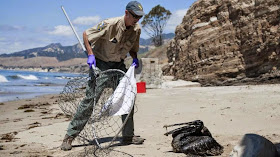MAY 23, 2015
LOS ANGELES (AP)
We have been arguing for years now that the PHMSA is not up to par with the oversight of the oil and gas pipelines. The oil and gas pipelines are filthy dirty operations and they leak like sieves in many areas. The pipelines are underground and we do not see what is happening, unless and until there is a disaster like the one in Santa Barbara, California. With so many more gas and oil pipelines being built, the frequency of the severe oil spills will only increase, as we have been noticing since 2010.
Furthermore, another group of corrupt and incompetent feds is the FERC. These people have even created their own noise standards that make the very noisy air compressors sound as if they are purring cats. Incompetence and corruption up and down the ladder in these agencies. These people must be fired and replaced by competent, not-corruptible personnel who would put the lives of the local communities and the environment first. Energy is good, but we can all live with less driving, less heat and less plastic in our lives. But we cannot live with constant noise from an air compressor, or polluted water or polluted air.
The pipeline that leaked thousands of gallons of oil on the
California coast was the only pipe of its kind in the county not required to
have an automatic shut-off valve because of a court fight nearly three decades
ago, a county official said.
The original owner of the pipeline skirted the Santa Barbara
County requirement by successfully arguing in court in the late 1980s that it
should be subject to federal oversight because the pipeline is part of an
interstate network, said Kevin Drude, deputy director of the county's Energy
and Minerals Division. Auto shut-off
valves are not required by federal regulators.
"It's the only major pipeline that doesn't have auto
shut-off," Drude said. "For us, it's routine."
Federal regulators are investigating the cause of Tuesday's
leak that spilled up to 105,000 gallons of crude oil from an underground pipe
into a culvert and as much as 21,000 gallons into the ocean at Refugio State
Beach. The spill killed untold numbers of fish, a few pelicans and mired other
birds, sea lions and at least one elephant seal in the muck.
Plains All American Pipeline was still draining the pipe and
trying to locate the leak Friday. Federal regulators ordered the company to
remove the damaged section and send it to a lab for tests on the metal, along
with a series of other steps before it could resume pumping oil through the
pipe to inland refineries.
While it's not known if an auto shut-off valve would have
detected the leak and reduced the size of the spill, environmentalists have
criticized the lack of such a device, saying it could have shut the leaking
pipe down sooner.
"Everyone is pretty mystified why the pipeline didn't
automatically shut down when the leak occurred," said Linda Krop, chief
counsel of the Environmental Defense Center.
County regulations sometimes go beyond state and federal
standards, requiring additional environmental analysis or imposing conditions
to further protect health and the environment, Drude said. One additional
requirement that's standard is a valve that can detect changes consistent with
a leak and automatically shut down.
Richard Kuprewicz, president of Accufacts Inc. who
investigates pipeline incidents, said such valves aren't always effective, though
newer more sophisticated "smart" models provide more accurate signals
that can trigger shutdowns.
A Plains employee discovered the leak early Tuesday
afternoon, about three hours after mechanical issues with the pipeline,
according to the company. The pipe was restarted for about 20 minutes before a
pump failed and then it was shut down because of changes in pressure.
The company said it was looking into whether those earlier
problems led to the leak.
A surge in pressure from starting up a system could cause a
leak or exacerbate one, but it's too soon to tell, Kuprewicz said.
"In the past, surge pressures have caused pipes to
rupture, but there were other failures, too," he said, speaking in general
and not about the Plains incident. "If that were the case that would
become fairly evident ... pretty quickly."
Plains All American subsidiaries have reported at least 223
accidents along their lines and spilled a combined 864,300 gallons of hazardous
liquids since 2006, according to federal records. The company has been subject
to 25 enforcement actions by federal regulators and tallied damages topping $32
million.
The company has defended its record, saying accidental
releases have decreased as its pipelines have increased to 17,800 miles.































